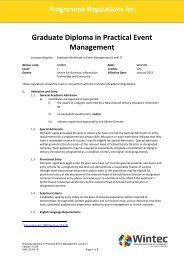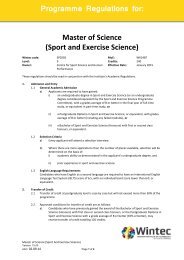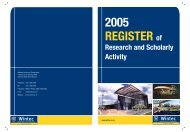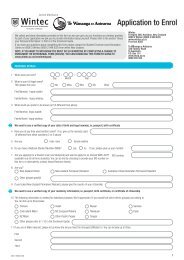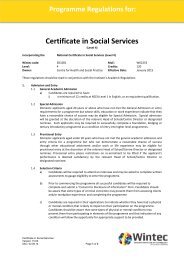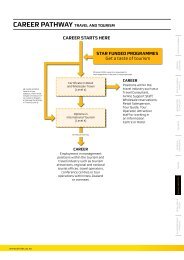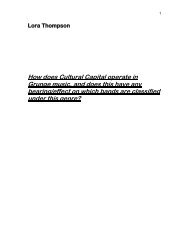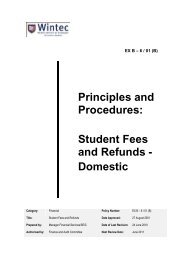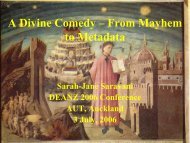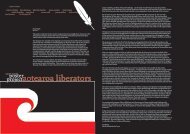2012 wintec annual report
2012 wintec annual report
2012 wintec annual report
You also want an ePaper? Increase the reach of your titles
YUMPU automatically turns print PDFs into web optimized ePapers that Google loves.
WINTEC ANNUAL<br />
REPORT <strong>2012</strong><br />
47<br />
Work in progress is recognised at cost less impairment and is not<br />
depreciated.<br />
In most instances, an item of property, plant, and equipment is<br />
initially recognised at its cost. Where an asset is acquired at no<br />
cost, or for a nominal cost, it is recognised at fair value as at the<br />
date of acquisition.<br />
Disposals<br />
Gains and losses on disposals are determined by comparing the<br />
disposal proceeds with the carrying amount of the asset. Gains and<br />
losses on disposals are <strong>report</strong>ed net in the surplus or deficit. When<br />
revalued assets are sold, the amounts included in the property<br />
revaluation reserves, in respect of those assets, are transferred to<br />
general funds.<br />
Depreciation is provided on a straight-line basis on all property,<br />
plant, and equipment other than land and heritage collections,<br />
at rates that will write off the cost (or valuation) of the assets to<br />
their estimated residual values over their useful lives. Heritage<br />
collections are not depreciated because they are maintained<br />
such that they have indefinite or sufficiently long useful lives that<br />
depreciation is considered negligible.<br />
Class of assets<br />
Rate (pa)<br />
Land 0%<br />
Furniture and equipment 5% - 33.33%<br />
Motor vehicles 20%<br />
Library 20%<br />
Computer hardware 20% - 33.33%<br />
Buildings<br />
Structure<br />
1 - 84 years<br />
Fit out<br />
1 - 19 years<br />
Services<br />
1 - 22 years<br />
Infrastructure<br />
10 - 50 years<br />
Leasehold improvements are depreciated over the shorter of the<br />
unexpired period of the lease or the estimated remaining useful<br />
lives of the improvements.<br />
The residual value and useful life of an asset is reviewed, and<br />
adjusted if applicable, at each financial year end.<br />
Held for sale<br />
Property, plant and equipment is re-classified as a current asset<br />
held for sale when its carrying amount will be recovered principally<br />
through a sale transaction rather than through continuing use.<br />
The re-classification takes place when the asset is considered to be<br />
available for immediate sale in its present condition subject only<br />
to the usual and customary terms for sales of such assets and the<br />
sale is considered highly probable.<br />
Intangible assets and goodwill<br />
Computer software<br />
Acquired computer software licenses are capitalised on the<br />
basis of the costs incurred to acquire and bring to use the<br />
specific software.<br />
Costs that are directly associated with the development of<br />
software for internal use are recognised as an intangible asset.<br />
Direct costs include the software development employee costs and<br />
an appropriate portion of relevant overheads.<br />
Staff training costs are recognised as an expense when incurred.<br />
Costs associated with maintaining computer software are<br />
recognised as an expense when incurred.<br />
Course development costs<br />
Course development costs are recognised as an expense in the<br />
Statement of Comprehensive Income in the year in which they<br />
are incurred.<br />
Intellectual Property Development<br />
Research costs are recognised as an expense in the surplus or<br />
deficit in the year in which they are incurred.<br />
Amortisation<br />
The carrying value of an intangible asset with a finite life is<br />
amortised on a straight-line basis over its useful life. Amortisation<br />
begins when the asset is available for use and ceases at the date<br />
that the asset is derecognised. The amortisation charge for each<br />
period is recognised in the surplus or deficit.<br />
FINANCIAL PERFORMANCE<br />
1<br />
2<br />
3<br />
4<br />
5<br />
6<br />
7<br />
8<br />
9<br />
10



